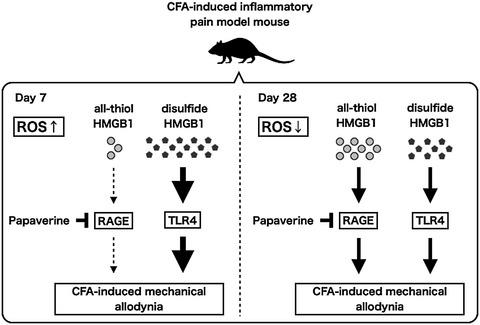Our official English website, www.x-mol.net, welcomes your feedback! (Note: you will need to create a separate account there.)
Antinociceptive activity of the novel RAGE inhibitor, papaverine, in a mouse model of chronic inflammatory pain
SYNAPSE ( IF 2.3 ) Pub Date : 2020-09-26 , DOI: 10.1002/syn.22188 Kazumi Yoshizawa 1 , Kota Takeuchi 1 , Toka Nakamura 1 , Saki Ukai 1 , Yukino Takahashi 1 , Akira Sato 2 , Ryoko Takasawa 3 , Sei-Ichi Tanuma 4
SYNAPSE ( IF 2.3 ) Pub Date : 2020-09-26 , DOI: 10.1002/syn.22188 Kazumi Yoshizawa 1 , Kota Takeuchi 1 , Toka Nakamura 1 , Saki Ukai 1 , Yukino Takahashi 1 , Akira Sato 2 , Ryoko Takasawa 3 , Sei-Ichi Tanuma 4
Affiliation

|
Extracellular high‐mobility group box 1 (HMGB1) is known to mediate the inflammatory response through pattern recognition receptors, including the receptor for advanced glycation end products (RAGE) or the toll‐like receptors (TLRs). The aim of the present study was to investigate whether papaverine, a novel RAGE inhibitor, could suppress inflammatory pain in mice after several time points, which was induced by the injection of complete Freund's adjuvant (CFA). We also investigated the influence of redox modulation during a state of chronic inflammatory pain. Although papaverine did not suppress CFA‐induced mechanical allodynia on Day 7, papaverine significantly suppressed CFA‐induced mechanical allodynia on Days 14 and 28. In contrast, the radical scavenger N‐tert‐Butyl‐α‐phenylnitrone (PBN) suppressed mechanical allodynia in mice on Days 7 and 14, but not on Day 28. We demonstrated that the RAGE inhibitor improves mechanical allodynia in chronic inflammatory conditions. Moreover, we also found that high levels of reactive oxygen species (ROS) contributed to the early phase of CFA‐induced mechanical allodynia. Precisely, lower ROS levels contributed to the inflammatory pain response via the all‐thiol HMGB1/RAGE signaling pathway during the chronic state. These findings led us to propose that ROS levels modulate RAGE and/or TLR4‐mediated inflammatory allodynia by regulating the concentrations of disulfide HMGB1 or all‐thiol HMGB1.
中文翻译:

新型 RAGE 抑制剂罂粟碱在慢性炎症性疼痛小鼠模型中的镇痛活性
已知细胞外高迁移率组框 1 (HMGB1) 通过模式识别受体介导炎症反应,包括晚期糖基化终产物受体 (RAGE) 或 toll 样受体 (TLR)。本研究的目的是研究一种新型 RAGE 抑制剂罂粟碱是否可以在几个时间点后抑制小鼠的炎症性疼痛,这是由注射完全弗氏佐剂 (CFA) 引起的。我们还研究了在慢性炎症性疼痛状态下氧化还原调制的影响。虽然罂粟碱在第 7 天没有抑制 CFA 引起的机械性异常性疼痛,但罂粟碱在第 14 天和第 28 天显着抑制了 CFA 引起的机械性异常性疼痛。相比之下,自由基清除剂N-叔-丁基-α-苯基硝酮 (PBN) 在第 7 天和第 14 天抑制小鼠的机械性异常性疼痛,但在第 28 天没有。我们证明 RAGE 抑制剂可改善慢性炎症条件下的机械性异常性疼痛。此外,我们还发现高水平的活性氧 (ROS) 有助于 CFA 诱导的机械异常性疼痛的早期阶段。确切地说,在慢性状态下,较低的 ROS 水平通过全硫醇 HMGB1/RAGE 信号通路促进了炎症性疼痛反应。这些发现使我们提出 ROS 水平通过调节二硫化物 HMGB1 或全硫醇 HMGB1 的浓度来调节 RAGE 和/或 TLR4 介导的炎症异常性疼痛。
更新日期:2020-09-26
中文翻译:

新型 RAGE 抑制剂罂粟碱在慢性炎症性疼痛小鼠模型中的镇痛活性
已知细胞外高迁移率组框 1 (HMGB1) 通过模式识别受体介导炎症反应,包括晚期糖基化终产物受体 (RAGE) 或 toll 样受体 (TLR)。本研究的目的是研究一种新型 RAGE 抑制剂罂粟碱是否可以在几个时间点后抑制小鼠的炎症性疼痛,这是由注射完全弗氏佐剂 (CFA) 引起的。我们还研究了在慢性炎症性疼痛状态下氧化还原调制的影响。虽然罂粟碱在第 7 天没有抑制 CFA 引起的机械性异常性疼痛,但罂粟碱在第 14 天和第 28 天显着抑制了 CFA 引起的机械性异常性疼痛。相比之下,自由基清除剂N-叔-丁基-α-苯基硝酮 (PBN) 在第 7 天和第 14 天抑制小鼠的机械性异常性疼痛,但在第 28 天没有。我们证明 RAGE 抑制剂可改善慢性炎症条件下的机械性异常性疼痛。此外,我们还发现高水平的活性氧 (ROS) 有助于 CFA 诱导的机械异常性疼痛的早期阶段。确切地说,在慢性状态下,较低的 ROS 水平通过全硫醇 HMGB1/RAGE 信号通路促进了炎症性疼痛反应。这些发现使我们提出 ROS 水平通过调节二硫化物 HMGB1 或全硫醇 HMGB1 的浓度来调节 RAGE 和/或 TLR4 介导的炎症异常性疼痛。



























 京公网安备 11010802027423号
京公网安备 11010802027423号